Coq au Vin is the well-known French chicken stew where pieces of meat are braised in a luscious, glossy red wine sauce with bacon, mushroom and onions. Like Beef Bourguignon, the beauty of this dish lies in its simplicity. There are remarkably few ingredients and it’s a simple process, but the results are fit for a king – or queen!
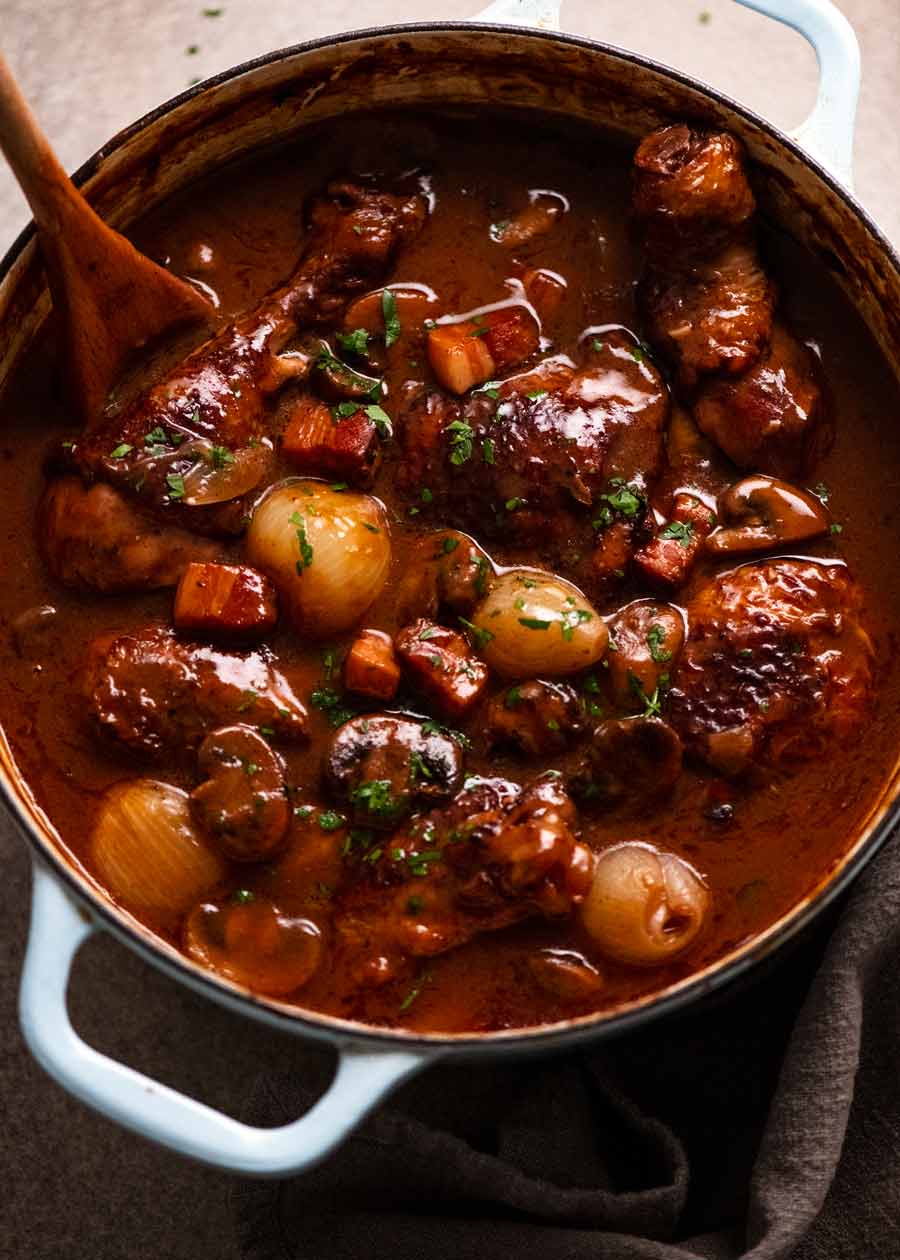
Coq au Vin – French chicken stew
Chicken stews are delightful and criminally underrated in my book. Too often they play second fiddle to the divas of the stew world like lamb shanks, braised short ribs and curries. Maybe it’s because chicken as a meat is considered somewhat “common”? As a result, delicious and hardworking dishes like this Everyday Chicken Stew (with crispy skin!) or this weeknight Fast Chicken Stew just don’t get their share of the love they deserve.
If there’s any dish that can rise above the image problem that most chicken stews suffer though, it’s got to be Coq au Vin. This French (naturally!) classic is all about succulent bone-in chicken pieces braised in a glossy, alluringly dark and rich red wine sauce. The sauce’s deeply savoury flavour perfumed with herbs and bacon is complex and seems to just linger forever. If I had to call it (and regular readers know I will!), I reckon Coq au Vin is hands down the greatest and certainly the most luxurious chicken stew in the world!
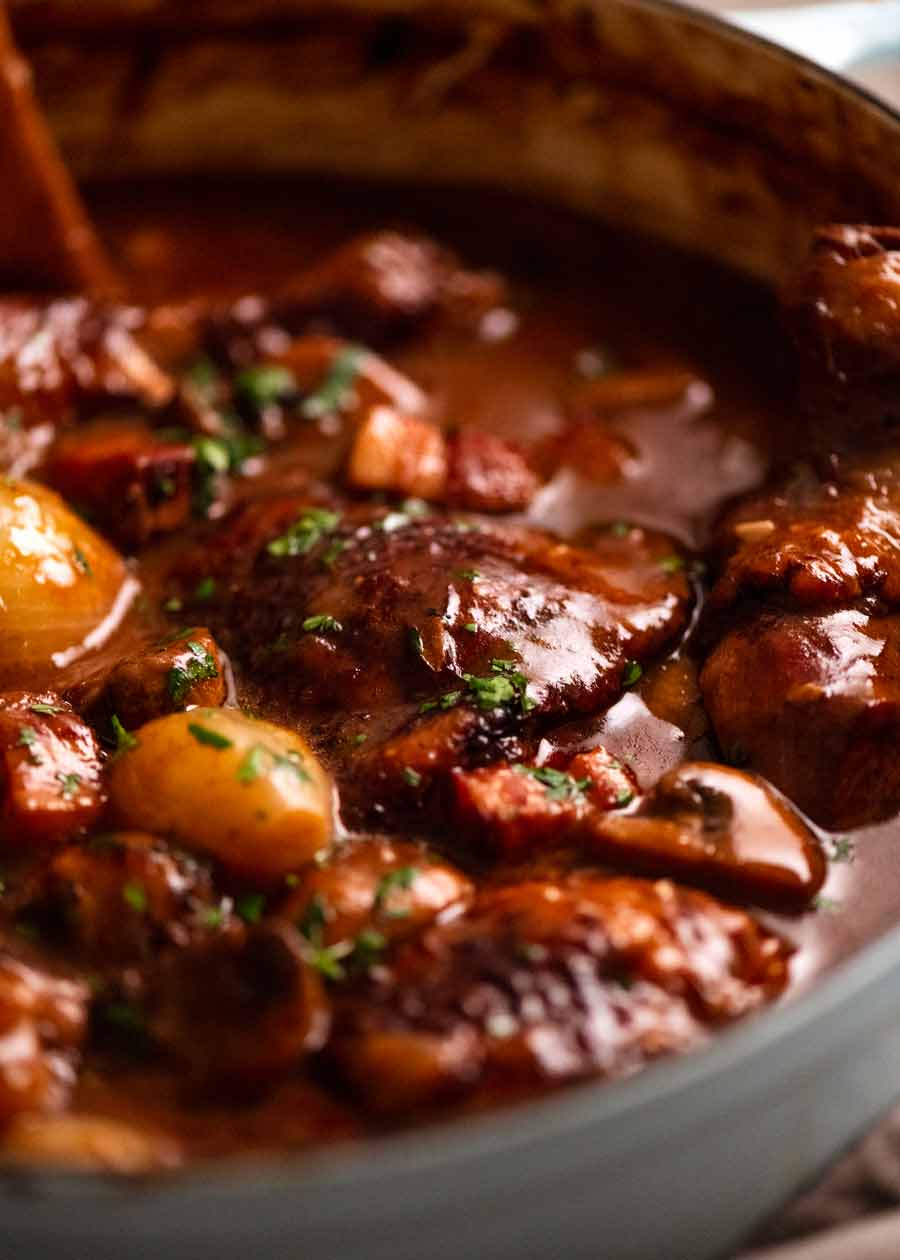
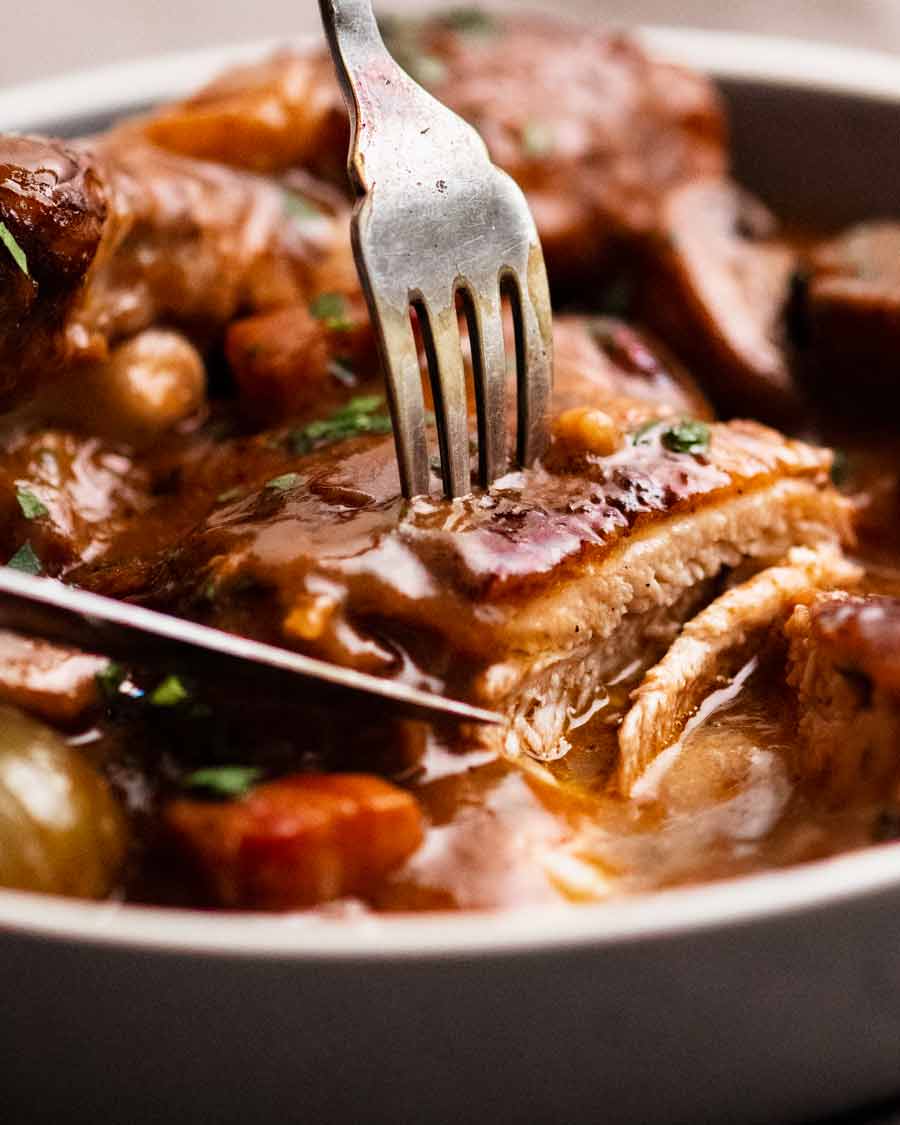
Yet there’s actually less ingredients than any of the stews mentioned earlier. The recipe is surprisingly straightforward. Making a great Coq au Vin instead is all about small additional steps and details that add up little by little to weave the magic into this magnificent stew. Trust me: Take the time to make this properly and I promise you’ll never look at chicken stew the same way again!
What you need to make Coq au Vin
1. Chicken and red wine marinade
Here’s what you need to marinate the chicken. The red wine is first used for marinating the meat and later reduced on the stove to make the sauce.
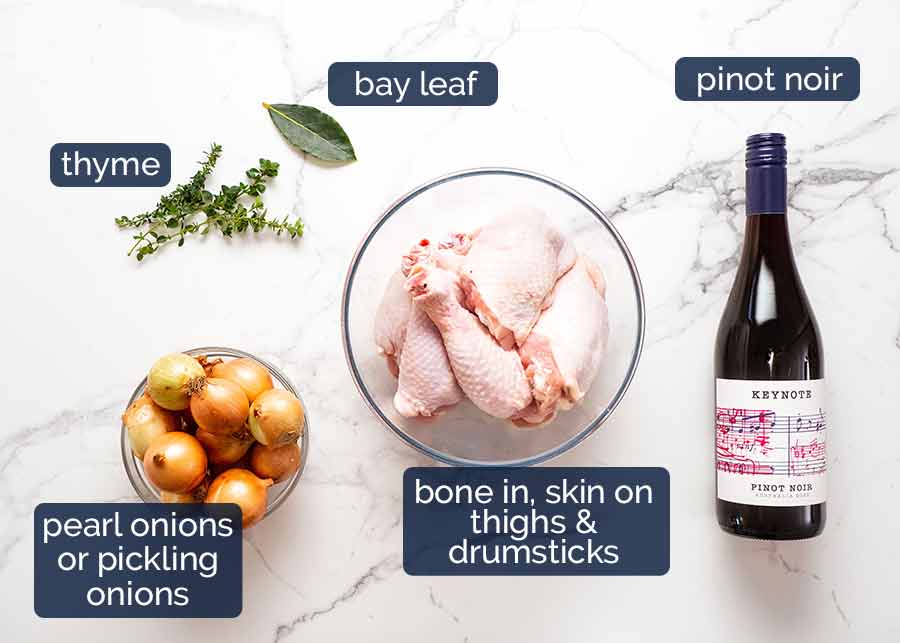
Chicken pieces – Coq au Vin literally means “rooster in wine”. Once upon a time older male chickens may have been the bird of choice for this traditional dish. I don’t know about you, but where I live roosters are hard to come by, so regular chicken it is!
Bone-in, skin-on thighs and drumsticks are the safest for the most tender, juicy results. Cutting up your own whole chicken would also be an option (and more traditional). Keep the chicken breast whole with the skin on and bone in. Marinate and sear per recipe but only put it in the pot for the last 20 minutes in the oven (else it will overcook and dry out)
Red wine – The key flavouring in this dish used to infuse chicken with flavour, and base for the sauce. The finished dish does taste mildly of red wine if served immediately which is exactly how it is supposed to taste. However, if you leave the finished dish overnight in the fridge (highly recommended), the flavour of the stew develops and the wine flavour mellows so you can barely taste it.
Pinot Noir is the traditional wine typically used in Coq au Vin, usually from Burgundy. In France different wine regions showcase their local wines to create variations of chicken-in-wine dishes (sometimes even champagne!).
Really though any red variety will do as long as it’s not too heavy and full-bodied – shiraz, cabernet sauvignon, merlot, malbec are all good.
Wine quality – Even though wine is the primary flavouring in this dish, there’s still no need to splurge on expensive wine. The old adage that you should “only cook with wine you’d drink” has largely been consigned to the dustbin of culinary myths thanks to modern wisdom, such as from authorities like the New York Times, who found from tests that “the wonderful wines and the awful ones produced equally tasty food, especially if the wine was cooked for more than a few minutes.”
The braising time and other flavours works wonders to transform even economical wine – just rummage through the discount bins at your local liquor store. The bottle I used was a $15 one, reduced to $6 (Dan Murphy’s!).
Pearl onions are very small onions and are irritatingly hard to find in Australia. The closest are pickling onions which are slightly bigger, so just peel an extra layer or two off to make them the right size – around 2.5cm/1″ in diameter. Soak them for 10/15min in cold water, which will soften the skin and make them easier to peel (use a small knife to assist). You can also just use 2 regular brown or yellow onions, halved then cut into 1cm / 2/5” wedges.
Thyme and bay leaves – Classic French stew-friendly herb aromatics.
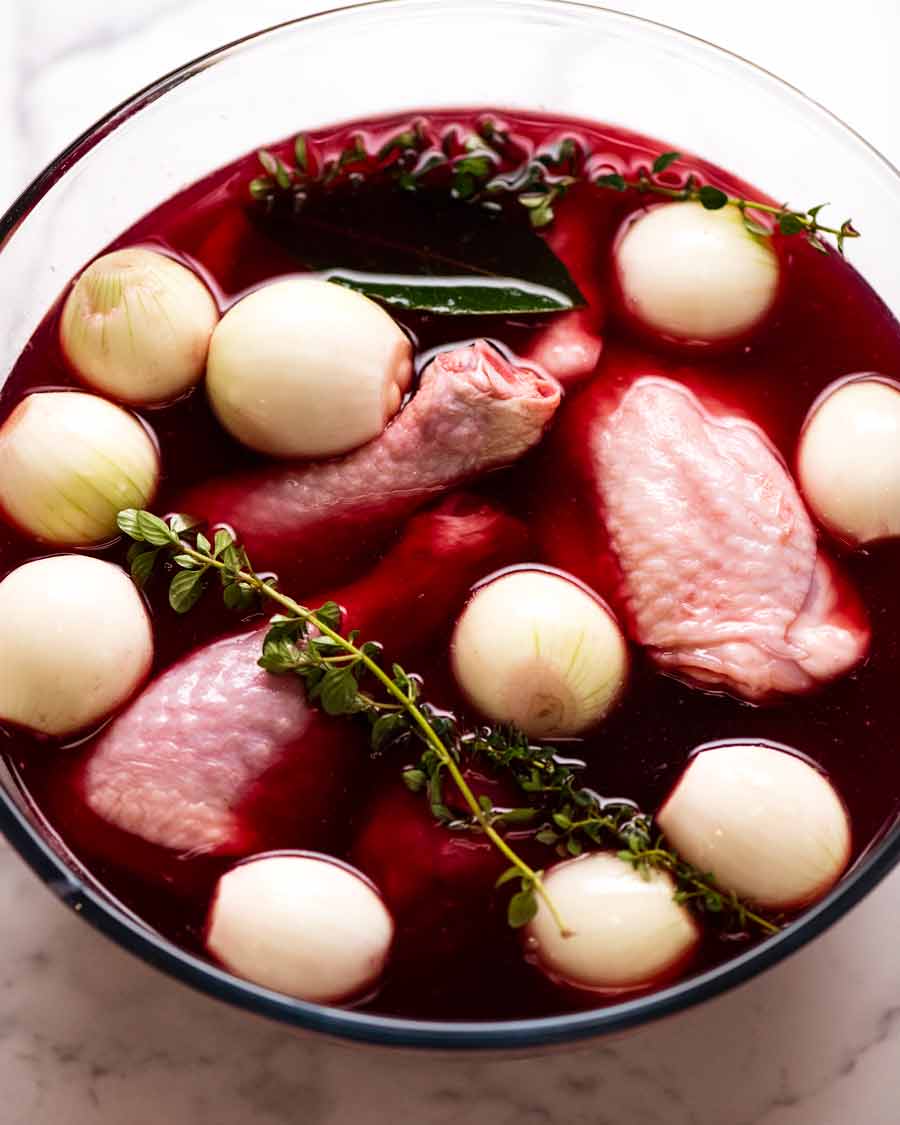
Marinating chicken in red wine for Coq au Vin 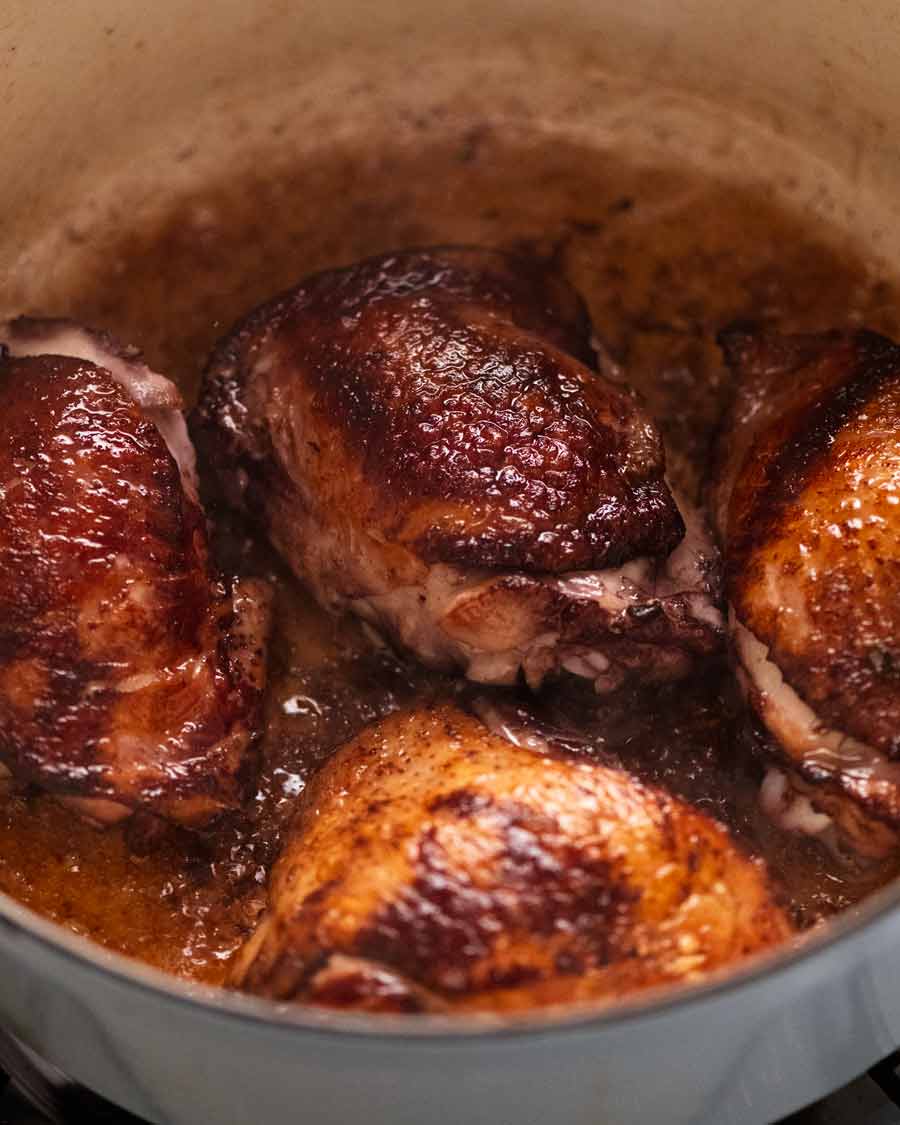
Searing chicken
2. For the Coq au Vin
In addition to above, here are the other ingredients that go into the Coq au Vin:
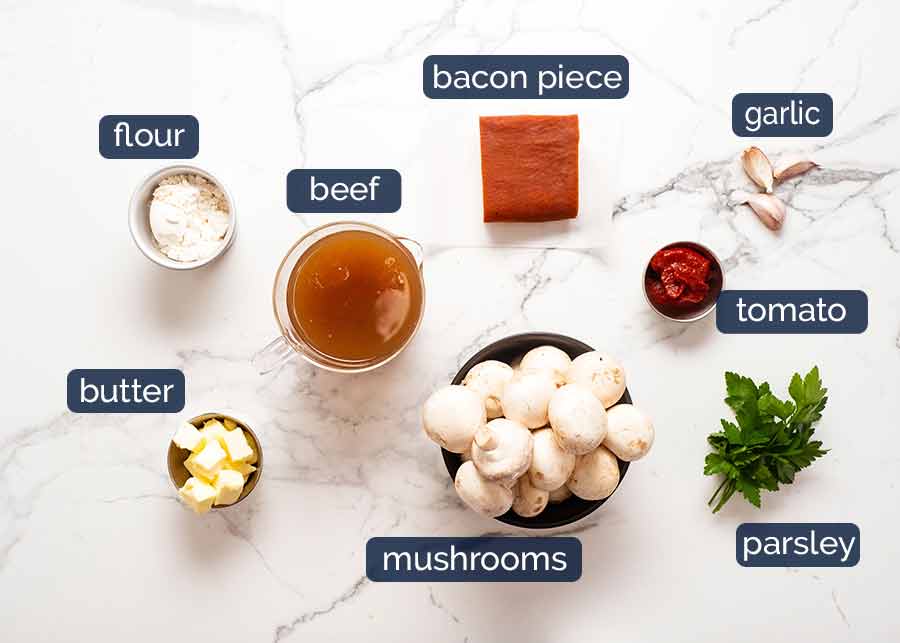
Beef stock is the stock of choice for this dish. That might sound strange for a chicken stew, but it’s what gives it the really rich, dark colour and deeper flavour. Cooked out with all the other ingredients it doesn’t taste beefy at all, because you get so much flavour from the chicken juices. Chicken stock will work fine but the sauce colour won’t be as deep, and the flavour will be a little lighter.
Beef stock quality is the key variable here that will set apart a good homemade Coq au Vin from an exceptional restaurant-quality one. Homemade beef stock trumps any store bought. Good quality store-bought from butchers etc. are far better than mass-produced (like Campbell’s here in Australia).
Do not use powdered beef stock. It’s frankly inferior to even the packet liquid stock and has no place here amongst all this effort, I’m afraid!
Bacon – Get slab bacon from your butcher if you can, so you can cut it yourself into big, chunky lardons (batons). Biting into chunks of meaty bacon lardons as opposed to scrappy small shreds is part of what makes a great Coq au Vin so appealing!
If you can’t find slab bacon, try speck (which in Australia is smoked pork belly chunks). Failing that, normal bacon slices works just fine too from a flavour perspective but you’ll have more bacon “bits” in the sauce which is not quite as handsome!
Mushrooms – Just your everyday button mushrooms. Cut large ones into quarters, medium ones in half.
Swiss brown /cremini are also fine. White is more traditional and looks nicer because the paler colour stands out more against the dark brown sauce.
Garlic – For flavouring (it’s rare to see a savoury dish around here without it!).
Tomato paste – For a touch of brightness, to help thicken the sauce, flavour and colour.
Flour – This is what thickens the Coq au Vin sauce.
How to make Coq au Vin
For the most delicious and authentic Coq au Vin that truly stacks up to the best bistro and restaurant versions in France:
Rest the finished dish overnight to allow the flavours to develop further; and
Use homemade rather than store-bought beef stock.
1. Marinate chicken and sear
Don’t skip the overnight marination. This infuses the chicken with flavour all the way through to the bone.
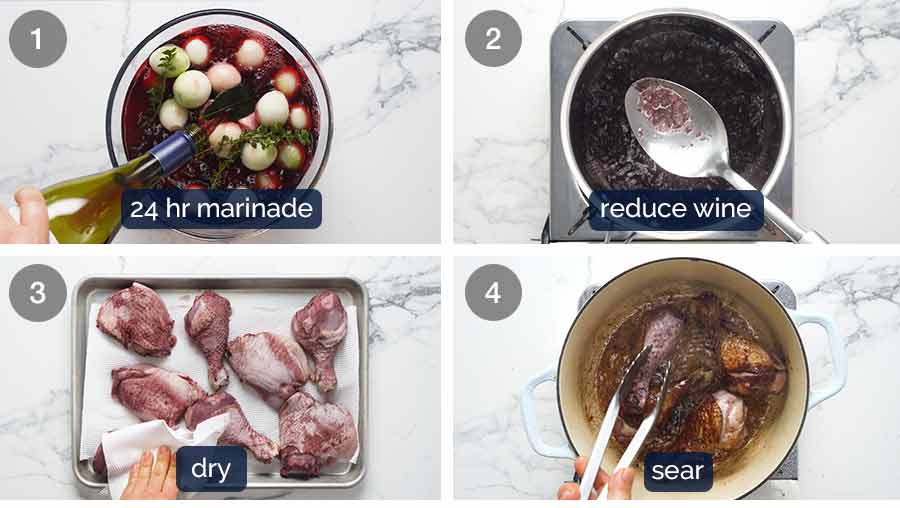
Marinate chicken – Using a glass or ceramic bowl, marinate the chicken overnight in the red wine, onion and herbs. 12 hours is the minimum recommended, up to 24 hours. Beyond this is still fine but doesn’t really add anything more, I’ve found.
This step infuses the chicken with flavour and is an essential part of what makes Coq au Vin so great. So don’t skip it!
Reduce wine – Strain the red wine into a pot and reduce by half on the stove. This intensifies the flavour, cooks out most of the alcohol and reduces the amount of liquid down to the right amount so you end up with a lovely thickened stew sauce by the time the chicken is cooked instead of a dilute, watery soup.
Dry chicken – Separate the onion and herbs from the chicken (because we add them into the stew at different times). Place the chicken in a paper towel-lined tray, then user paper towels to pat the chicken dry. This ensures that the chicken browns nicely. Wet chicken just won’t get a nice golden crust.
Sear chicken – Using a large heavy based pot 26cm / 10.5″ or larger), heat oil over medium high heat. Sear the chicken thighs first, starting with the skin side down, until they become a deep, dark golden colour. It will be darker than usual because the chicken is stained by the red wine. Flip and repeat on the other side.
In this step, we are just searing the outside of the chicken for flavour. The inside will still be raw which is fine since we will cook it through when we braise it.
Once the thighs are browned, remove and add the drumsticks. Because of the shape of the drumsticks, it’s harder to brown them evenly. Just rotate them to do the best you can – I normally sear 3 or 4 sides, about 5 minutes in total.
2. Make the Coq au Vin stew
While Coq au Vin produces magnificently deep and rounded flavours that only slow-cooking can, it actually only calls for 45 minutes of braising because chicken cooks considerably faster than, say, beef. In contrast, Beef Bourguignon takes a good 2 1/2 hours!
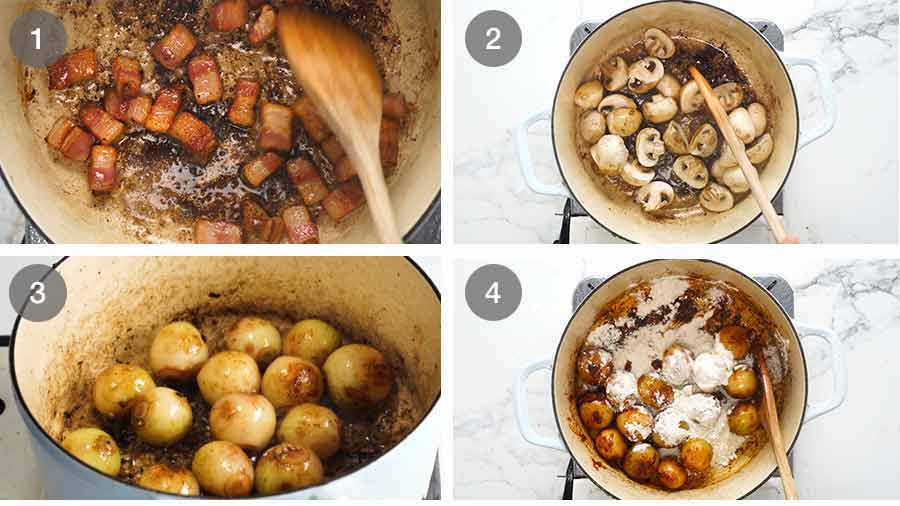
Sautéing each of the ingredients separately is key for developing some nice golden colour thus flavour. Don’t try to shortcut it but throwing them all in at the same time – they will steam up and go watery instead of becoming golden!
An enamelled cast iron pot similar to that shown above (26cm / 10.5″) or a Dutch oven is the best pot for this job. It retains tons of heat and you’re also less likely to have problems with burnt bits caking your pot base.
Cook bacon – Cook the bacon lardons until golden. In this step, quite a bit of fat will be released by the bacon which we will use to sauté subsequent ingredients. Once the bacon is done, add it to the tray with the chicken.
Sauté mushrooms – Next, cook the mushrooms in the bacon fat, still on medium-high heat. Again, just cook them until you get blush of golden on the surface because they will finish cooking in the stew. When the mushrooms are done, remove them and add to the chicken pile.
What to do if your pot base is blackening! If at any stage the base of the pot starts to get a thick layer of black and burnt “stuff” on it (tends to happen if you skimped on the fat!), remove it from the heat and use a flat paddle wooden spoon to scrape the layer off as best you can. If you don’t, that burnt layer will end up dissolving in your stew and make it bitter.
Onions – Now, in go the onions! Just stir regularly until you get nice golden patches on them. We do onions last because they hold up best when adding in the tomato paste and flour in the next steps.
Tomato paste and flour – Next, add butter and let it melt. Add garlic and cook it for 1 minute until the garlic is golden and it smells ridiculously good.
Then add the tomato paste and cook it for 2 minutes. This mellows the sourness of tomato paste as well as bringing out and concentrating the flavour.
Now add the flour and cook it for a further 2 minutes. We want to cook out the raw flavour of the flour so there won’t be even the smallest hint of flouriness in the final sauce. The mixture will be a bit pasty or sometimes, if you have less oil, possibly a bit crumbly. That’s ok – what’s important here is using the 7 tablespoons of flour specified in the recipe as this is what is required to ensure the sauce thickens to the right consistency by the time the chicken is cooked.
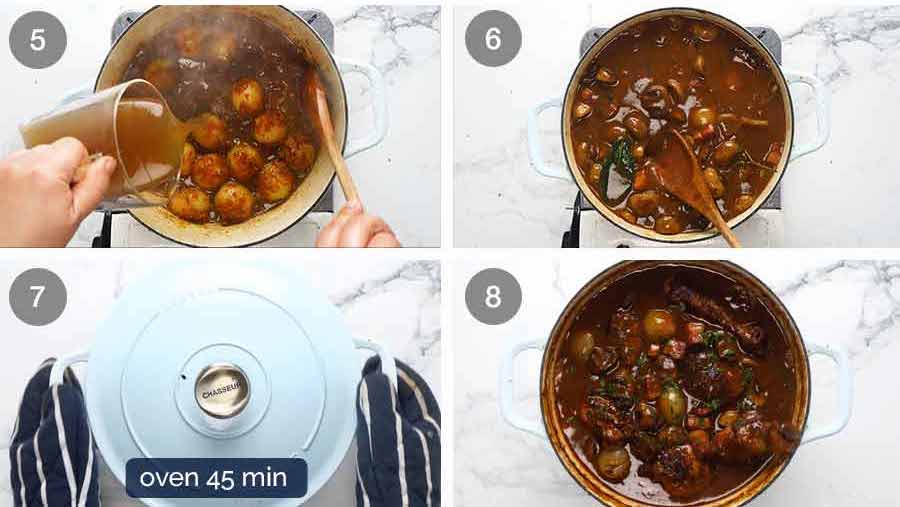
Add liquids – While stirring, slowly pour in the beef stock. Incorporating the stock little by little helps the flour dissolve lump-free into the liquids. But don’t worry if you do (or think you do!) have small lumps, they will easily dissolve during the braising time.
Once the beef stock is added, keep stirring to completely dissolve the flour into the liquid. Then mix in the reduced red wine.
Add chicken and everything else – Add the chicken, cooked mushrooms, bacon, and reserved bay leaf and thyme (from marinating the chicken) to the pot. Give it a good stir, then allow it to come to a simmer.
Oven 45 minutes – Cover with a lid then transfer it to a 180°C / 350°F (160°C fan) oven for 45 minutes.
Why oven instead of simmering on the stove? It’s just easier and lower maintenance. For example there’s no need to stir to ensure the base doesn’t catch, which is harder to do when you’ve got big pieces of chicken in a pot that’s relatively full!
The oven temperature may seem a little high to you for a slow-cooked recipe. Actually though this temperature is the equivalent of low heat on a small stove burner so the stew is barely bubbling inside the pot.
Can I use a slow cooker? This can work but you’ll need to reduce on the stove at the end to thicken the sauce. Slow-cook for 6 hours on low. Transfer to pot then simmer (no lid) for 15 – 20 minutes until sauce reduces. I really think it’s just easier to use the oven, to be honest!
Sauce adjustments – Once the Coq au Vin comes out of the oven, the sauce should have reduced slightly and thickened into a thinnish gravy. If it’s still very thin, or too thin for your liking, just pop it on a low stove without the lid until it thickens to your taste. Things like the heat retention of your pot and oven strength will affect exactly how much the sauce reduces and thickens.
Pro tip: Keep the sauce slightly thinner than you would like to see it once served. This is because roux–thickened sauces like this will thicken further as they cool slightly and once served.
Adjust salt – Also, taste the sauce and add more salt if needed. I start with what I think is a conservative amount of salt because the saltiness of the finished dish will be affected by the saltiness of the bacon used – something I cannot control!
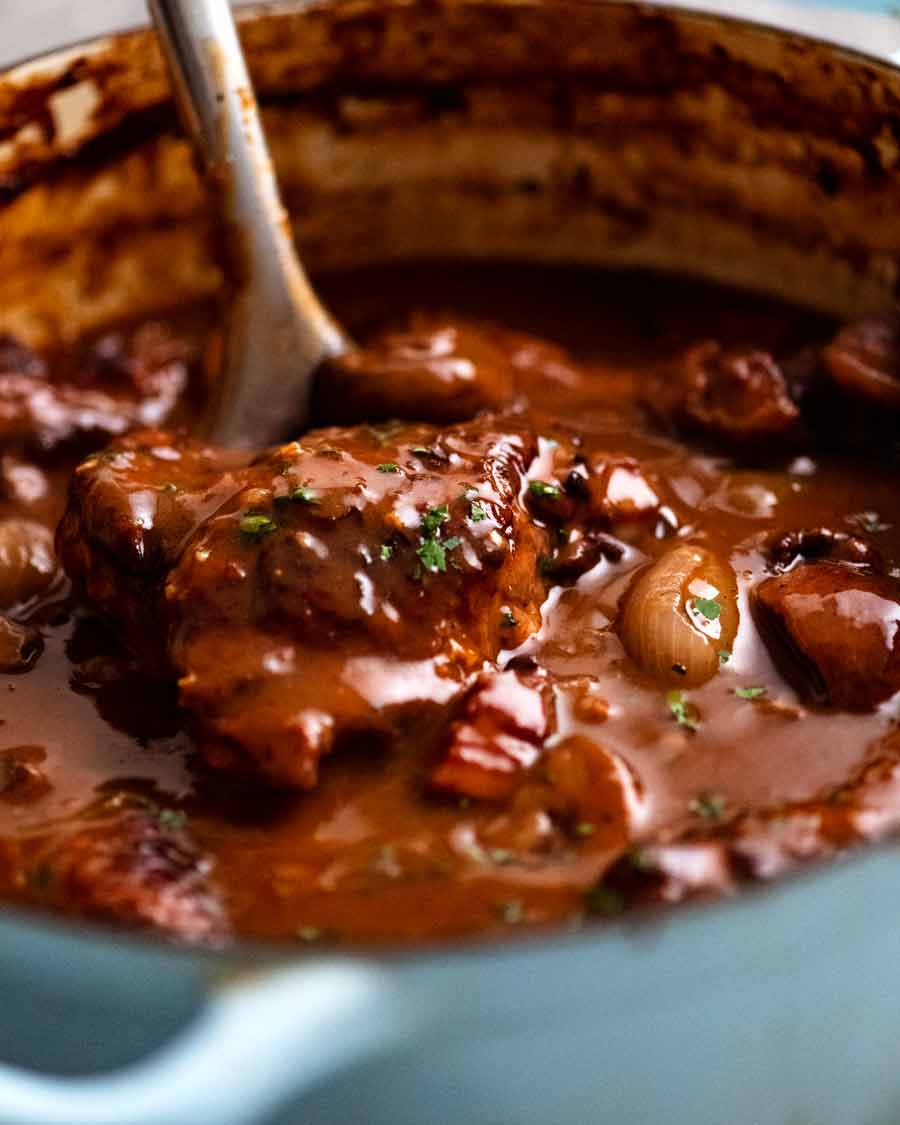
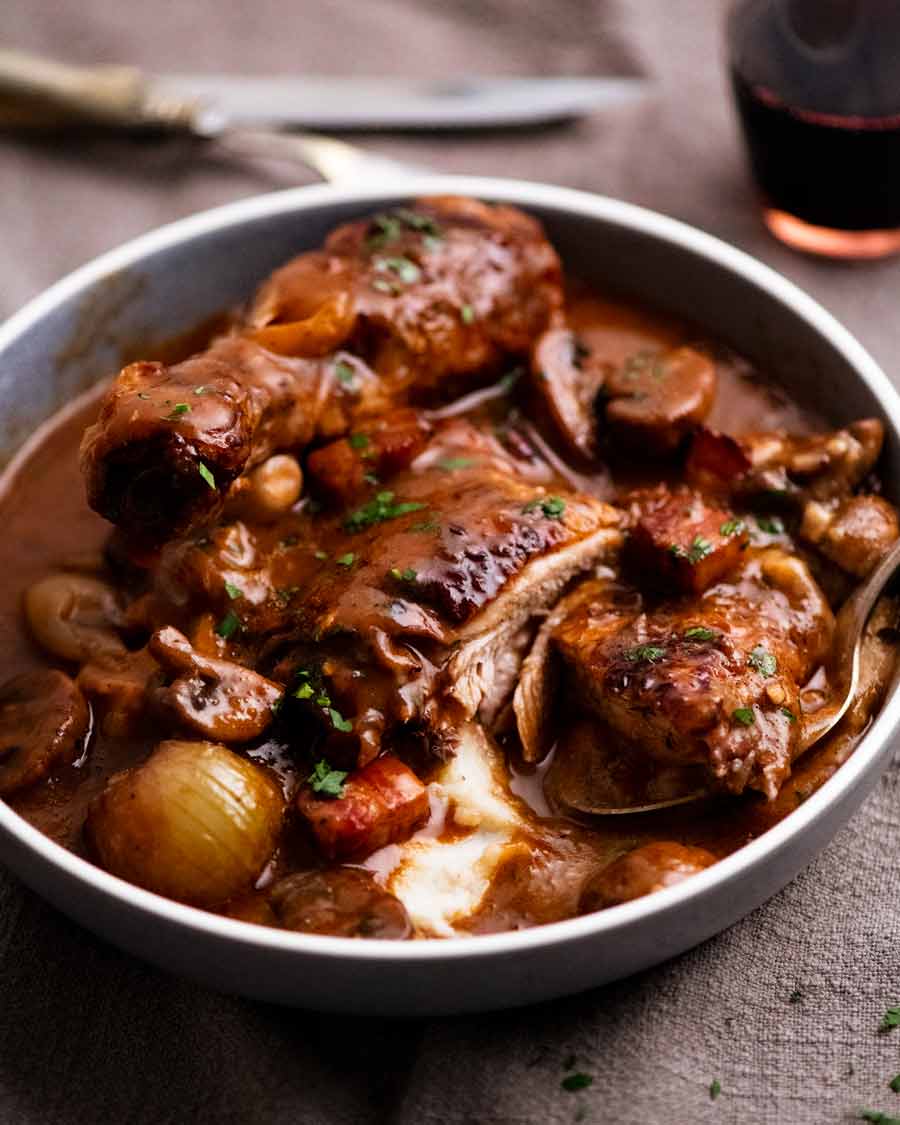
What to serve with Coq au Vin
Starchy vehicles to soak up that sauce!
While mashed potato is the clear and obvious starchy vehicle of choice here for scooping up all that luscious sauce, the other popular side in France is (surprisingly!) tagliatelle pasta. This is a flat noodle pasta that is 6mm / 0.236″ wide (to be accurate! 😉). Fresh is best, but dried is still perfectly good.
And while perhaps not traditional, I can confirm that a hunk of warm homemade brioche is a dreamy way to mop your bowl clean. Emphasis on DREAMY!!!
Side salad for Coq au Vin
Serve Coq au Vin with a nice crisp green salad lightly dressed with French Dressing or a classic French Bistro Salad. Made with leafy greens, a handful of herbs, and a pretty pink tangles of pickled eschalots this is a refreshing, lemon vinaigrette-dressed salad served in bistros all over France with the exact intended purpose of teaming up with rich mains like Coq au Vin.
Here are a few more side salad options that I think will go well with a hearty main like Coq au Vin:
French Desserts to finish!
Have you really had a proper French dinner if you don’t have dessert?? NO! 😂 Some suggestions:
It’s always hard to choose favourites, but for Coq au Vin, these are my top picks:
Creme Brûlée – A classic French bistro favourite that’s bafflingly simple to make at home.
Lemon Tart (Tarte au Citron) – My dessert of choice for its zesty and fresh flavour which makes for a perfect palette cleanser after a rather rich main.
Madeleines – This was dessert for we made for the last French dinner party I hosted. For something bite-size and a little different, freshly made Madeleines are a delightful way to finish off a meal. Make the batter beforehand and leave it in the fridge. It takes 90 seconds to fill the baking pan, and 10 minutes to bake. Pile on a plate and watch as they disappear in seconds!
Enjoy! – Nagi x
Watch how to make it
Hungry for more? Subscribe to my newsletter and follow along on Facebook, Pinterest and Instagram for all of the latest updates.
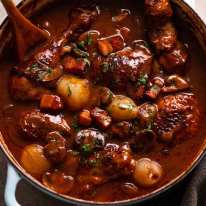
Coq au Vin
Ingredients
Red Wine Chicken Marinade:
- 4 chicken thighs , bone-in, skin on (~220g / 7 oz each) (Note 1)
- 4 chicken drumsticks (Note 1)
- 16 pearl onions or picking onions (Note 2)
- 1 bay leaf , fresh (dry also ok)
- 3 thyme sprigs (sub 1 tsp dried thyme)
- 750 ml / 3 cups pinot noir red wine , or other dry red wine (Note 3)
Browning Chicken:
- 3 – 4 tbsp vegetable oil (or canola oil)
- 3/4 tsp salt (cooking/kosher salt, or 1/2 tsp table salt)
- 1/2 tsp pepper
Coq au Vin Stew:
- 400g / 14oz white mushrooms , halved (quartered if large) (Note 4)
- 150g / 5oz bacon piece , (speck) cut into 1 x 2.5cm / 0.4 x 1″ batons (Note 5)
- 60g / 4 tbsp unsalted butter
- 3 garlic cloves , finely minced (with knife)
- 2 tbsp tomato paste
- 7 tbsp flour , plain / all purpose
- 750 ml / 3 cups beef stock , low sodium, preferably homemade (Note 6)
- 1/4 tsp salt (cooking/kosher salt, or 1/8 tsp table salt) (Note 7)
- 1/4 tsp black pepper
Garnish and serving:
- 2 tbsp parsley , chopped
- Mashed potato (or tagliatelle)
Instructions
Marinate chicken:
- Marinate chicken: Place the Chicken Marinade ingredients in a large glass or ceramic bowl or dish. Marinate overnight in the fridge (minimum 12 hours, maximum 24 hours).
- Strain wine into a bowl. Reserve herbs and wine. Separate the chicken and onion.
- Dry chicken: Spread chicken out on a try lined with paper towels, then pat dry with paper towels.
- Reduce wine: Pour red wine into a saucepan and bring to a boil over medium high heat. Simmer vigorously, skimming off any impurities that rise to the surface, until reduced by half. Set aside.
Brown chicken and vegetables:
- Preheat oven to 180°C / 350°F (160°C fan).
- Season chicken: Sprinkle chicken with 3/4 tsp salt and 1/2 tsp black pepper.
- Brown chicken: Heat 3 tbsp oil in a large, heavy-based, oven-proof pot over medium-high heat. Add chicken thighs skin side down and cook for 2 – 3 minutes until nicely browned (it will be darker than usual because of the red wine). Flip thighs and cook the other side for another minute to kiss it with a little colour. Remove to a tray. Pull at skin of drumsticks to cover flesh as best as possible, then brown (I do 3 to 4 sides, ~5 minutes in total). Remove and set aside.
- Fry bacon: Remove any loose black burnt bits. Add a bit of extra oil if needed, then cook bacon for 3 minutes until golden. Add to tray with chicken.
- Sauté mushrooms: Add mushrooms and cook for 5 minutes, or until golden. Remove into a separate bowl.
- Sauté onion: Add a bit of extra oil if needed, then cook onions for 5 minutes or until there are nice golden patches.
- Butter and flour: Add butter into pot. Once melted, add garlic and cook for a further 1 minute. Add tomato paste and cook for 2 minutes. Add flour and cook for 2 minutes.
- Add wine and stock: While stirring, slowly pour in beef stock – this helps the flour dissolve lump-free into the stock. Then add the reduced wine and mix until flour mixture is dissolved and mostly lump-free. (Note 8)
- Add everything back in: Add chicken, bacon, mushroom, thyme, bay leaf, salt and pepper into the pot, then stir.
SLOW-COOK:
- Oven 45 minutes: Bring to a simmer, then cover and transfer to oven for 45 minutes. Chicken will be very tender – but not "falling apart". (Note 9)
- Adjust salt: Remove from oven, taste sauce and add salt if needed.
- Leave overnight (recommended, Note 11): If time permits, leave the stew overnight before serving because as with all stews, it gets better with time! Reheat gently on a low stove in a covered pot, ensuring that chicken is fully heated through. Add water if needed to loosen sauce.
- Serve over mashed potato or tagliatelle, sprinkled with fresh parsley! For the ultimate experience, mop the plate clean with homemade brioche (surprisingly straight forward to make). See in post for side salad and dessert options.
Recipe Notes:
Nutrition Information:
Originally published September 2016, a recipe adapted from a cookbook by a celebrity chef. Coq au Vin was republished in September 2020 using a recipe taught to me by Chef Jean-Baptiste Alexandre, culinary contributor of all things French. His recipe is much (much!) better!
Life of Dozer
Yes Dozer. I made this ENTIRE cake for YOU…… not! 😂
PS It’s called a Fraisier which is a French strawberry cake which is filled with a custard buttercream called Mousseline cream. It’s work in progress!

And from the original publication date in September 2016:
Can someone remind me why I didn’t get a lap dog? Once, he spilled a whole bowl of meatballs when he lifted his head from under this very same table.


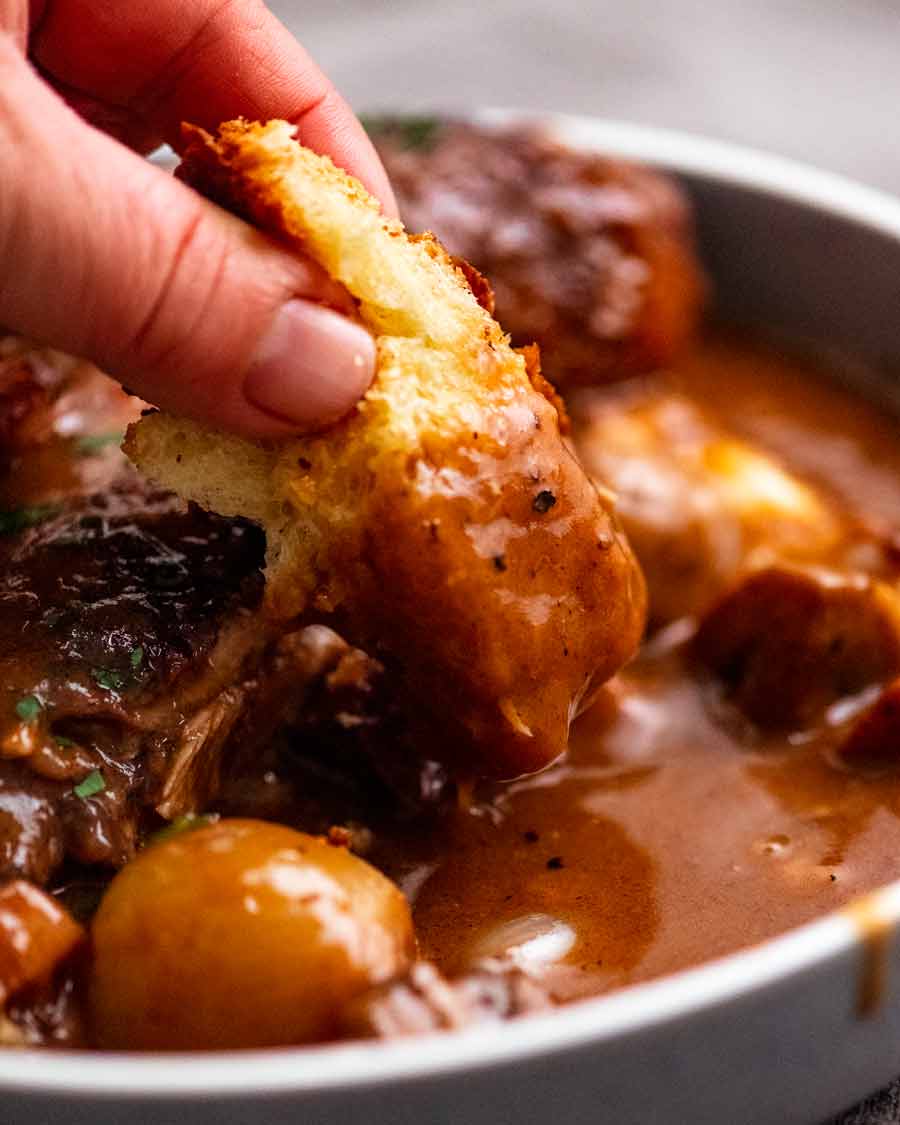
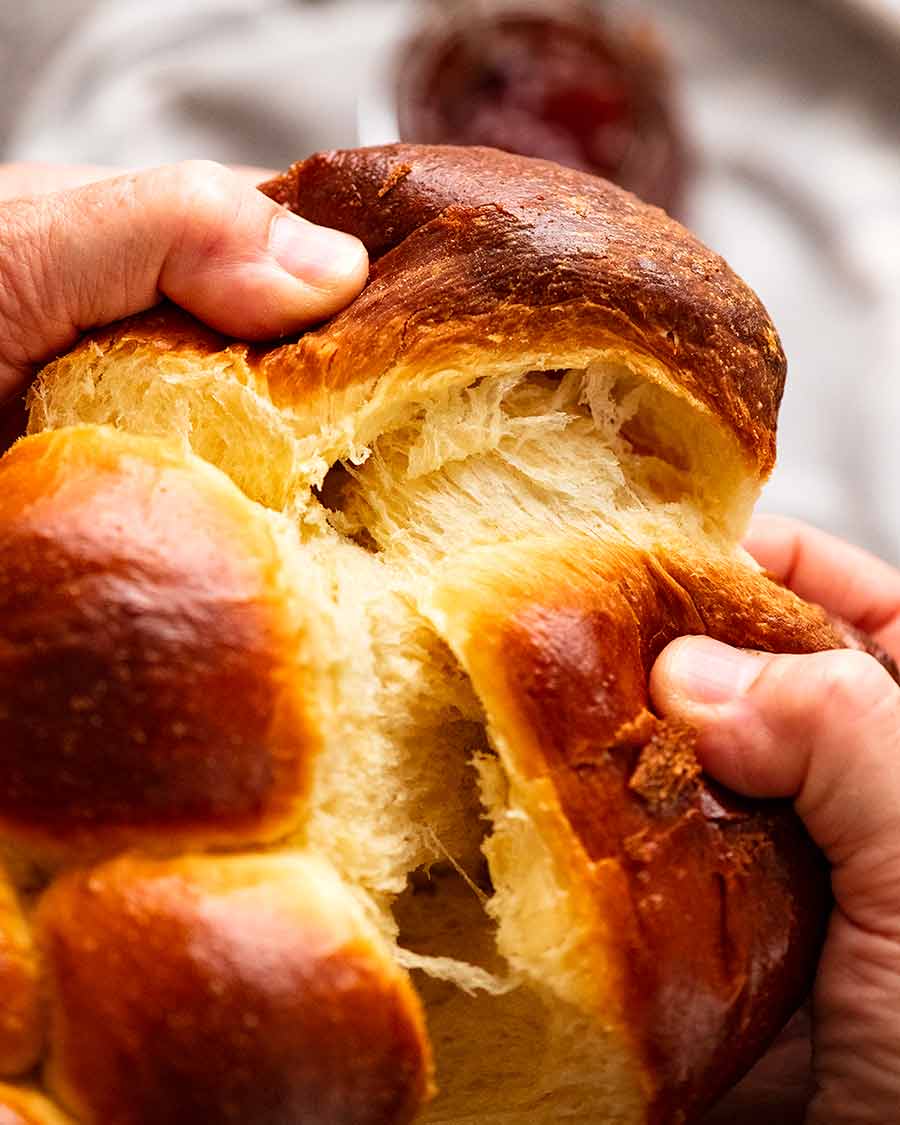
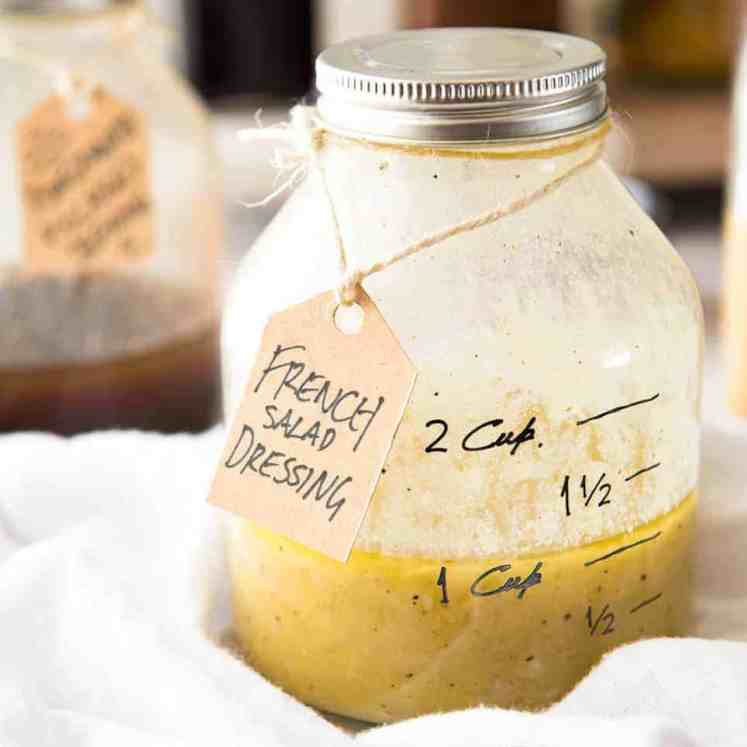
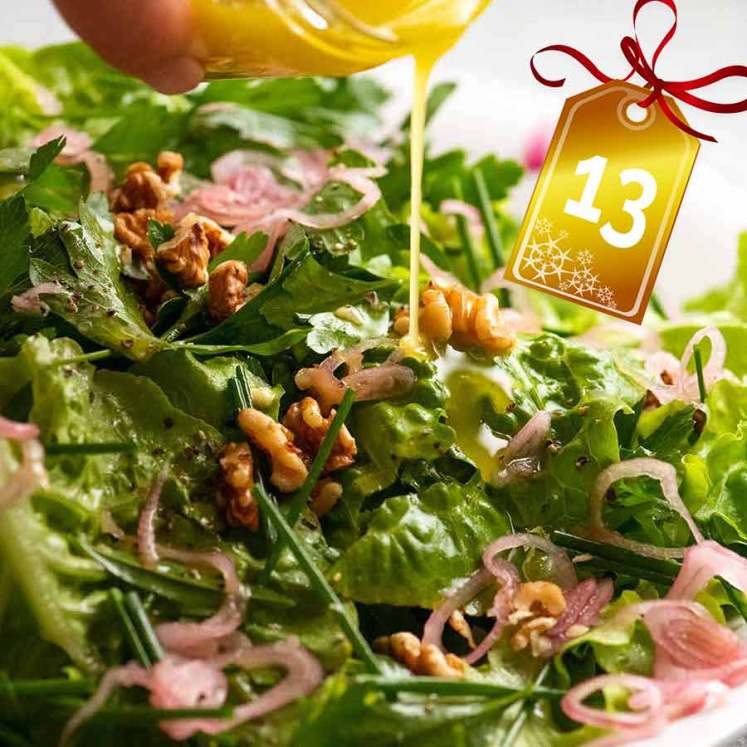
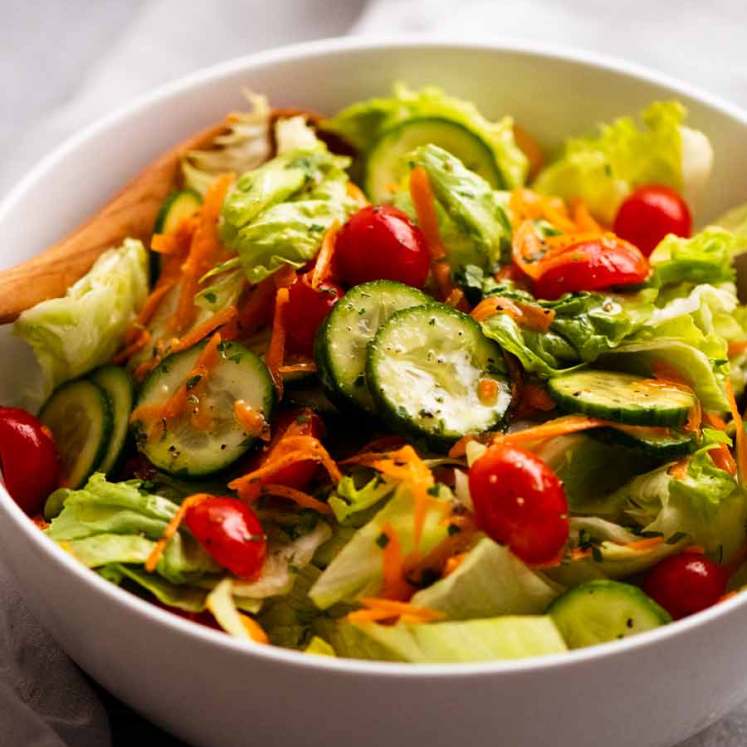
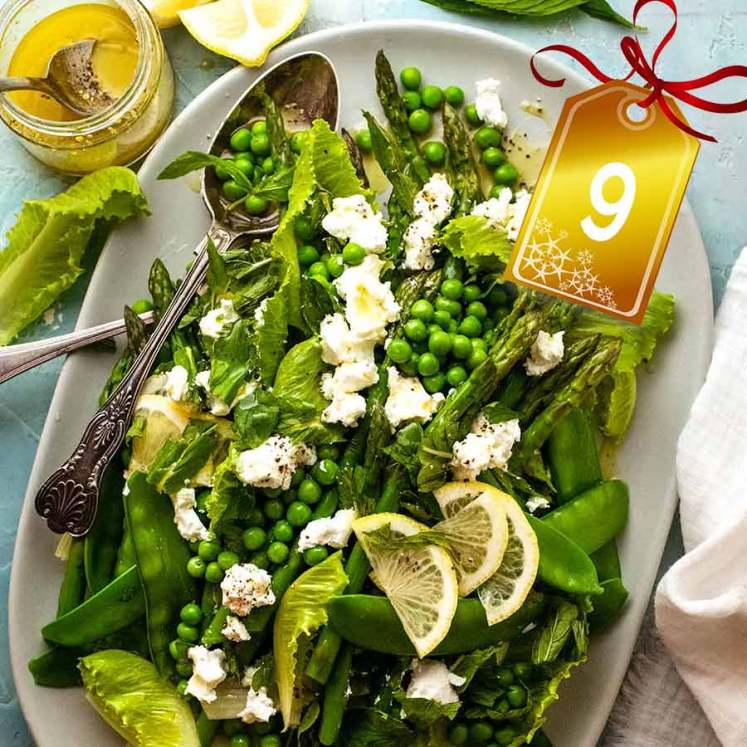
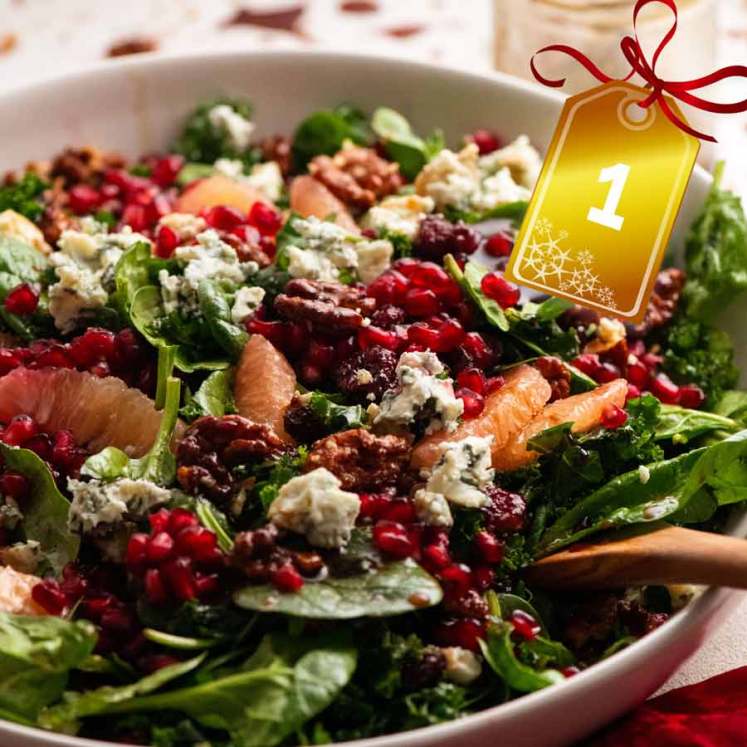
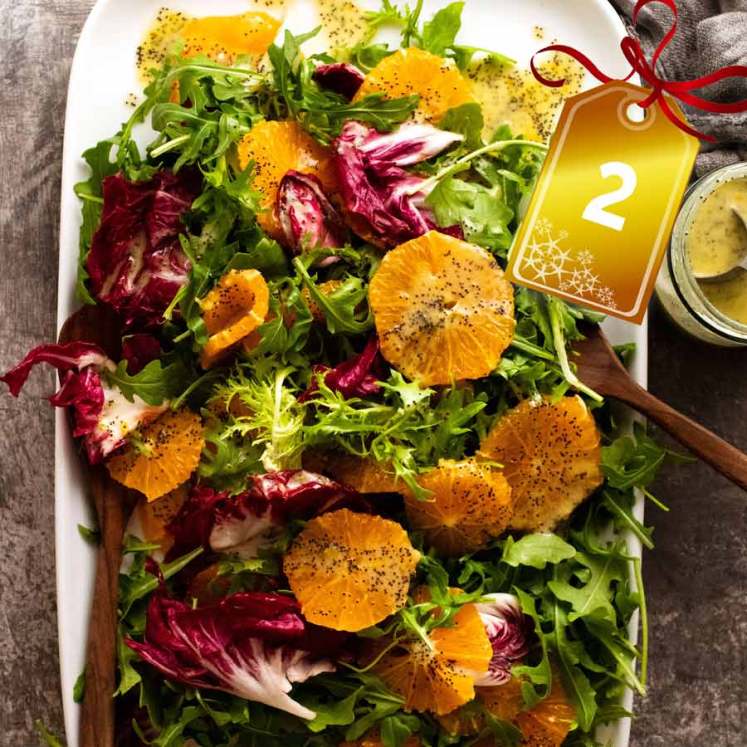
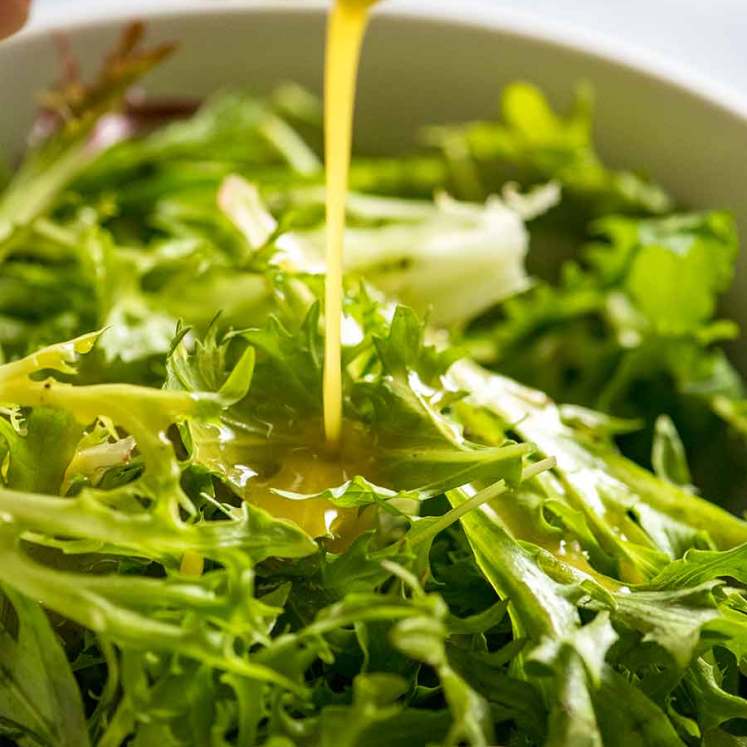
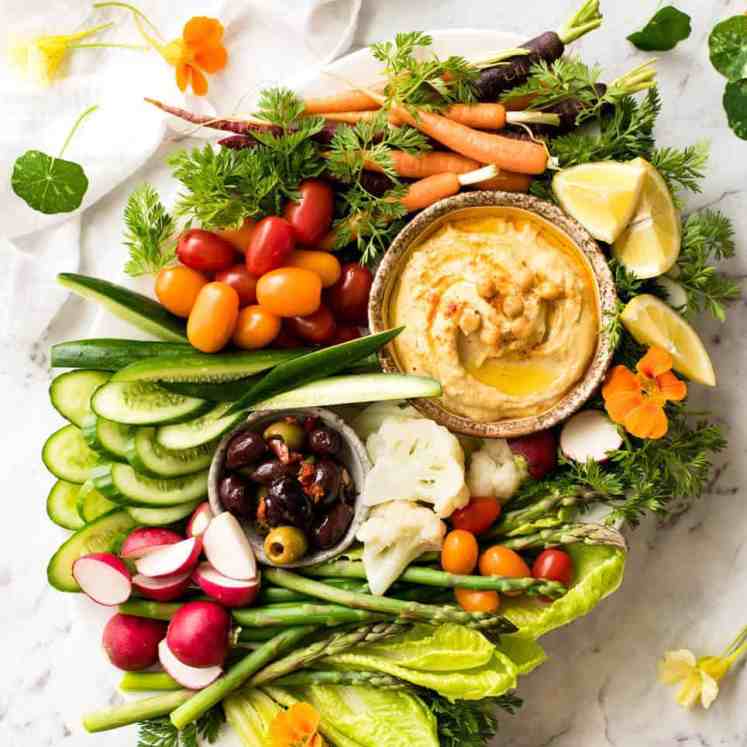




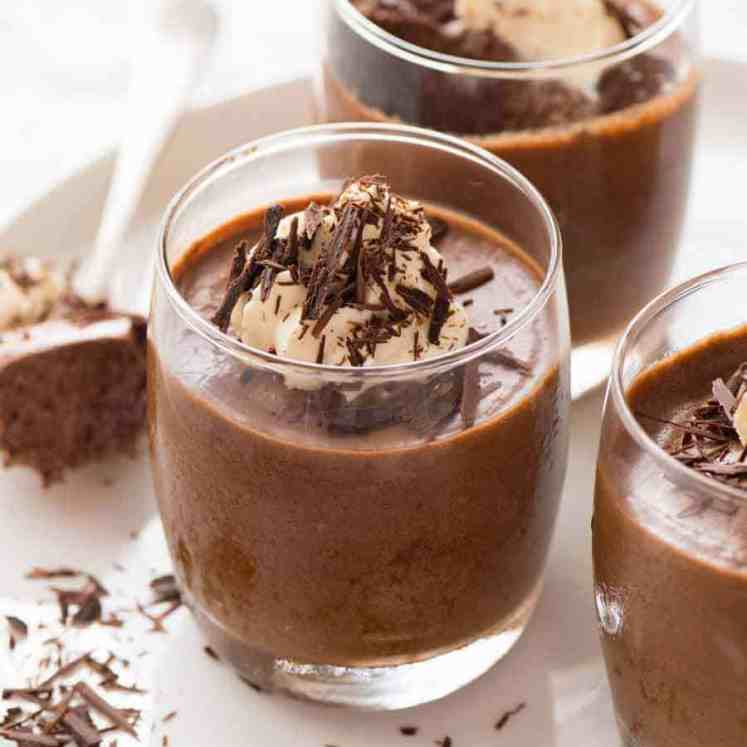

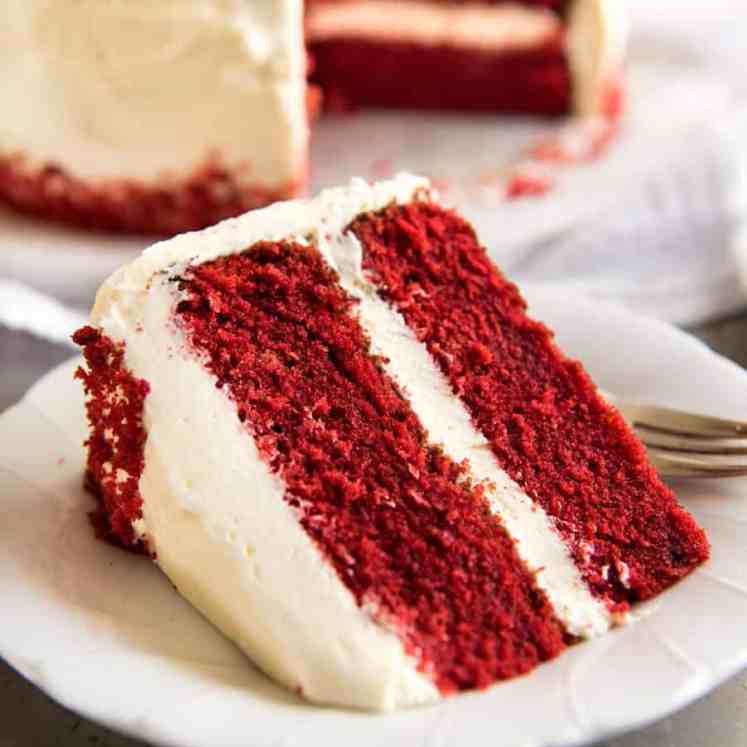
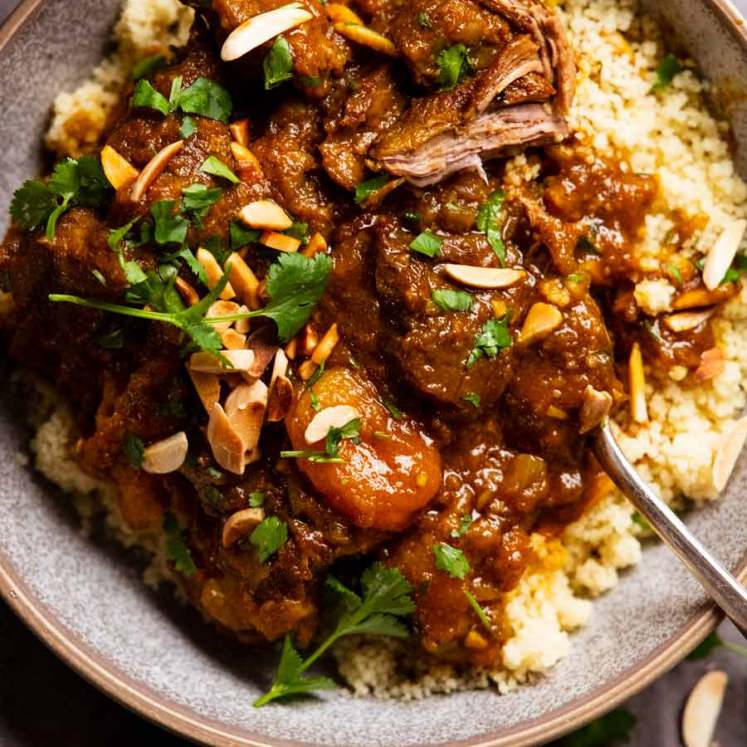
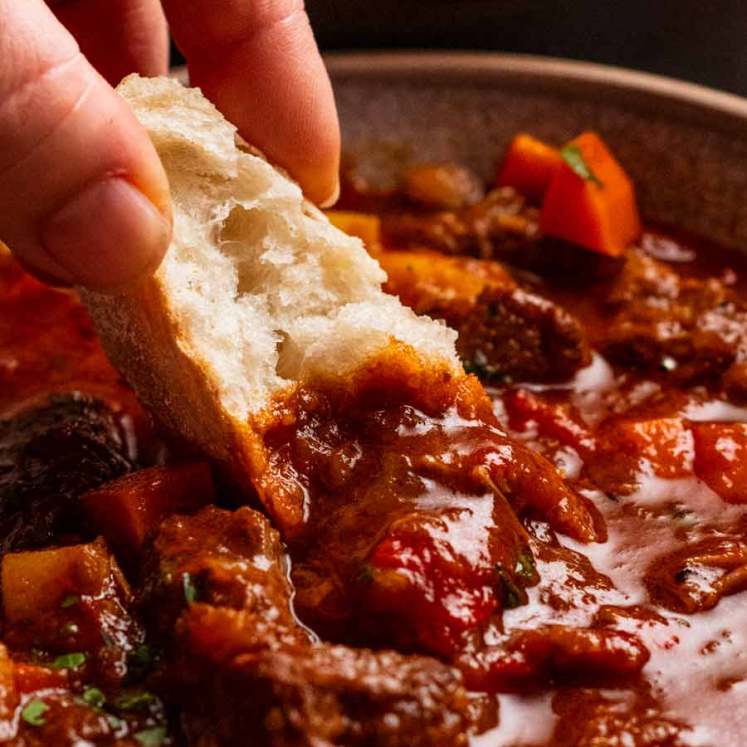
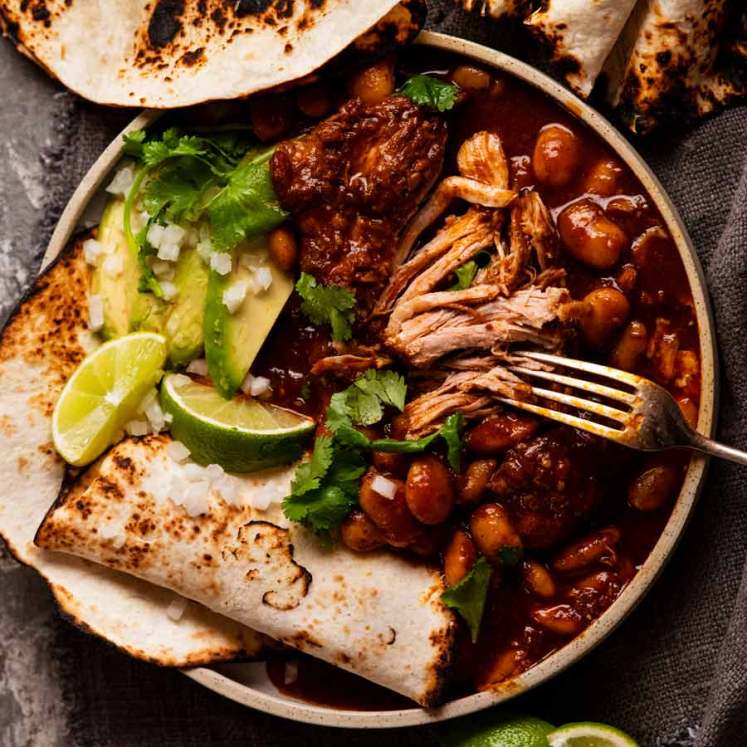
Hi Nagi,
I’m just cooking this now after marinating overnight. Will serve for tomorrow nights dinner (as suggested!😊) with French salad.
Yum! I’m so looking forward to this, as is hubby, will let you know how it turned out. Thanks again for a fab recipe. You have been my go to recipe gal for years now, nary a fail. Also, huge congrats on Recipetinmeals. You continue to amaze me. Thanks Nagi, xxx and hugs to Dozer 😝
Thanks so much Kate, I truly appreciate it! I hope you enjoy dinner! N x
Love this! I have a recipe request 😊 could you possibly show us your take on a cinnamon roll cake please? Would love to try your version as your recipes always work for me
Something like this Tuba Abro? https://www.recipetineats.com/easy-cinnamon-swirl-quick-bread/ N x
I like the Coq au Vin recipe but before I make it, I am confused by the details for the chicken. It reads as though the chicken pieces are included for the duration of 45 minutes cooking period in the oven. However, note 1 says to add the chicken pieces for the last 20 minutes? Please could you clarify. Regards, Trevor.
Hi Trevor, this is if you’re cutting up a whole chicken, the breasts will need to be cooked for the last 20 minutes only otherwise they will dry out – I hope this clarifies! N x
This looks amazing. Can I use a gluten free flour to thicken?
Sure can Verna, I usually sub with half the amount of cornflour in place of regular flour. N x
Once again, looks like you have another recipe winner, Nagi. I do have one question for you or maybe you could offer a how to cook method? I wanted to replicate a chicken fricassee recipe my mother made. Her recipe called for a stewing hen and not finding one, I bought a roasting hen at 5lbs. Do you think this hen might work? Any other suggestions would surely be appreciated.
Love your tip on using and how to with pickling onions. I’m in Florida and have a tough time finding jarred pearl onions, not frozen, yet always find pickling onions.
Thank you for everything and Tigger sends nose knocks to Dozier!
Hi Jack, feel free to pop any recipe requests on my recipe request page, I have a long list to get through. Just to clarify, this recipe uses fresh pickling onions – not pickled onions in a jar 🙂 N x
Thank you for your clarification on the onions, Nagi. I appreciate your quick reply .
This recipe looks so good! Can’t wait to try it.
You’re going to love it Zee!!! N x
you say lemon dressig but the recipe french salad dressing doesn’t show any lemon ???
The Bistro Salad has a lemon dressing 🙂 N x
thank you !!! will find it !
On of my favorite dinners and will be tonight again using this recipe instead. I can’t begin to tell you how many recipes I’ve pitched because yours is just that much better. So we will see with this one too. Dozer is breathtakingly beautiful in that picture about the butter. I wouldn’t care about a meatball cleanup! Well maybe, but I’d get over it fast, I’m such a softie with puppy dog eyes!
I need to know what you think Mary, keep me updated once you try it!!! N x
It was delicious and was labeled as “a keeper”. My recipe box is being thinned out by you, but for a very good reason. Question where would I put in a suggestion? It’s for a recipe for Moo Shu Pork or Chicken..
I love Coq au Vin, will yry this tomorrow and am seriously thinking of getting rid of all my cookery books! I love the way you explain things and give suitable alternatives if all are not available and also things that cannot be replaced.
Thank you, just have to learn more about cup sizes in UK.
xxx
Thanks so much for the great feedback Melanie – I also have metric measurements which are the same no matter where you’re located. Simply click the metric toggle at the top of the ingredients 🙂 N x
This looks amazing, Nagi … and ALMOST low carb. Is there any way to not use flour that doesn’t mess with the flavour shamefully? Thank you!
Hi Anne, sorry, the flour is what thickens the sauce nicely! N x
Another recipe to add to the ‘must do’ list. Any chance of a recipe book any time soon? I love your site but nothing beats a book complete with earmarked pages & cooking stains.
Hi,
This looks delicious!
Is it right to assume that the alcohol from the wine is cooked off?
So is okay for kids to eat this dish?
Thanks!
Hi Debby, most definitely, the alcohol is burnt off during the cooking process it is completely safe for kids 🙂 N x
Hi Nagi again. I raved about your Beef Bourguignon best one I’ve seen (how it should be) This recipe is brilliant as well. Will be making at the weekend. I know it will be good. Luv all your stuff. Keep them coming. (John M in the UK)
Thanks so much John!!! N x
Is there a non alcoholic marinate that can be used instead of the wine?
Hi Sussan, non-alcoholic wine would be the best sub here. N x
Absolutely LOVE a coq au vin!
Question however : there is a picky eater in this house that doesn’t like mushrooms!
Appreciate that they are a key ingredient in this dish, but wondering if there is anything to substitute for them. (I COULD try and pick them out before seen – but think the flavour will still shine through)
Hi Jo, you could just leave them out if you prefer 🙂 N x
Mushroom powder. Available on line. All varieties. You’ll get the flavour but no mushrooms for the picky eater.
Mushroom powder available online. All different types of mushrooms. Take your pick
Definitely have to give this one ago Nagi, sound very tasty. Stay safe down there ol’ mate the North is thinking of you..
Thanks so much Tony! N x
Dear Nagi,
MANY thanks 🙏 for your wonderful ways of explaining and improving so many classic recipes.
For years I thought that Delia Smith was the ultimate for beginners and reasonably advanced hobby cooks. But with your explicit descriptions and wonderful and informative pictures – not just the end product but the ingredients as well – you have left her well behind!!
Please keep it up!
Heiko
Woah what a lovely compliment, thanks SO much Heiko, that’s made my day!!! N x
Dear Nagi,
MANY thanks 🙏 for your wonderful ways of explaining and improving so many classic recipes.
For years I thought that Delia Smith was the ultimate for beginners and reasonably advanced hobby cooks. But with your explicit descriptions and wonderful and informative pictures – not just the end product but the ingredients as well – you have left her well behind!!
Please keep it up!
Heiko
As always something very nice.Thank you!
You’re so welcome Elena!! N x
Glad to see you came up negative on your test. Hope the others on your team come out the other side of their tests negative🤞 keep well and safe.
Thanks so much Ailsa!!! N x
Can I use home made chicken stock, instead of Beef stok?
Hi Doreen, beef has more flavour and is better for this recipe 🙂 N x